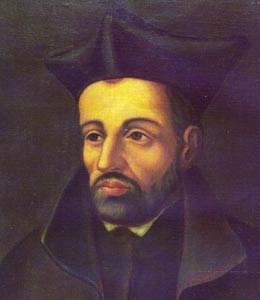 On November 26, 2013, I noted here that Pope Francis was going to canonize a Jesuit beatus known mostly by Jesuits. His name was thrust into the lime light by Francis when he spoke about Faber in the summer interview with Jesuit Father Antonio Spadaro. The interview revealed that the Pope loves Blessed Peter Faber:
On November 26, 2013, I noted here that Pope Francis was going to canonize a Jesuit beatus known mostly by Jesuits. His name was thrust into the lime light by Francis when he spoke about Faber in the summer interview with Jesuit Father Antonio Spadaro. The interview revealed that the Pope loves Blessed Peter Faber:
“Faber’s “dialogue with all, even the most remote and even with his opponents; his simple piety, a certain naïveté perhaps; his being available straightaway; his careful interior discernment; the fact that he was a man capable of great and strong decisions but also capable of being so gentle and loving.”
John Allen quotes Stefania Falasca, who referred to Blessed Peter Faber as “an important reference point for understanding the Pope’s leadership style.”
Today, in a private audience, the Pope met with Angelo Cardinal Amato, SDB, Prefect of the Congregation for the Causes of Saints, in which he gave us a new saint. Peter Faber is keenly remembered by the Jesuits as being among the early companions of Saint Ignatius, and very proficient in giving Loyola’s Spiritual Exercises; he died in Rome on 1 August 1546.
Some are likely wondering how can this papal act come about without the proper process of further investigation of miracles and the like. From New Advent we read:
Equivalent canonization occurs when the pope, omitting the judicial process and the ceremonies, orders some servant of God to be venerated in the Universal Church; this happens when such a saint has been from a remote period the object of veneration, when his heroic virtues (or martyrdom) and miracles are related by reliable historians, and the fame of his miraculous intercession is uninterrupted. Many examples of such canonization are to be found in Benedict XIV; e.g. Saints Romuald, Norbert, Bruno, Peter Nolasco, Raymond Nonnatus, John of Matha, Felix of Valois, Queen Margaret of Scotland, King Stephen of Hungary, Wenceslaus Duke of Bohemia, and Gregory VII. Such instances afford a good proof of the caution with which the Roman Church proceeds in these equivalent canonizations. St. Romuald was not canonized until 439 years after his death, and the honour came to him sooner than to any of the others mentioned. We may add that this equivalent canonization consists usually in the ordering of an Office and Mass by the pope in honour of the saint, and that mere enrollment in the Roman Martyrology does not by any means imply this honour (Benedict XIV, l, c., xliii, no 14).
It would be smart to remember that formula was used for the equivalent canonization of Saint Hildegard of Bingen by Pope Benedict XVI; he also declared her a Doctor of the Church.